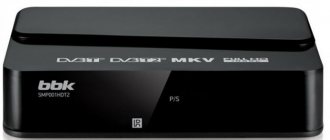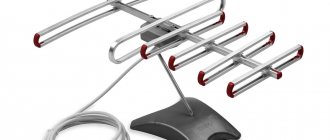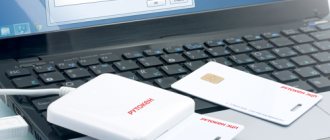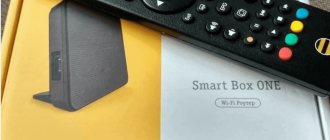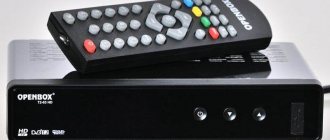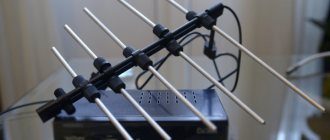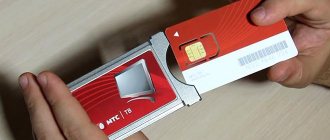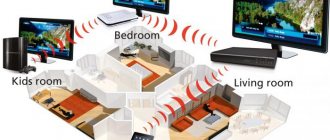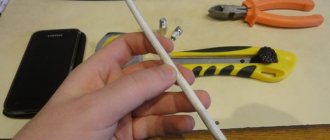Programs for watching TV on a computer
We have reviewed all the popular programs for watching and listening to foreign and Russian TV channels and radio stations in detail. Now let's characterize them briefly.
ComboPlayer is the most advanced software presented, a universal solution that combines the functionality of a streaming player, online TV/radio, download manager/torrent client and media player. The application is aimed at Russian-speaking users and is distributed free of charge, but some channels are available only by subscription. Note that its cost is simply ridiculous.
ComboPlayer's closest competitor is TV Player Classic. It is free, feature rich, but intended for advanced users. Beginners will not understand the overloaded interface. ProgDVB also has a similar problem , moreover, the developers ask for a license as much as 35 euros, and in the free version they give access to a minimum of functions.
Crystal and RusTV are suitable for users of all categories. The programs are simple, understandable, absolutely free, and provide access to all major domestic channels in real time. True, in terms of the number of channels and capabilities in general, RusTV wins.
Super TV , Online TV Player Free , Readon Movie Radio Player are alternatives to the solutions described above. We recommend trying them if you don’t find the channel or function you need in other programs. For example, no program except Super Internet TV allows you to play video at a network connection speed of 56 kbps. Try and choose!
Special services such as anyTV Free, Peers.tv, ChrisTV Online stand out. What stands out from the general background is Glaz.TV , available for viewing both in a browser and in a PC application. It captivates with one of the largest lists of free channels among analogues. Megogo to this list - the cinema has collected tens of thousands of films, TV series and various TV shows; you can watch a lot from its servers, but only by subscription. It is impossible not to mention the SPB TV mobile application, which is available for PCs and laptops in the Windows 10 brand store. It is very popular on the Internet.
If you don’t want to use special programs, the regular VLC Media Player will come to the rescue. It can play streaming via the torrent protocol, and you can find dozens of free playlists online. The tool does not require special configuration and supports this feature out of the box. Just find a suitable m3u playlist on the Internet.
Our review of TV programs did not include several other popular programs.
- For example Online Video Taker is a program that is still searched for on the Internet, but it has long been abandoned by its developers. The Mediaportal and Playbox Internet TV Online programs have a similar fate , which is also complained about by all self-respecting antiviruses.
- Ott Player is a tool that allows you to watch third-party channels on Smart TV. The player can be installed from any store directly onto your TV. It will be useful not only for movie fans, but also for users whose Internet provider supports its own TV streaming service. Just add a playlist or TV broadcast server address to Ott Player, and watch TV for free and without restrictions.
- the portable Perfect Player as a universal tool, but it refuses to work properly on Windows devices, but it works well on Android smartphones and tablets.
- The cross-platform service also includes the Lime HD TV . It offers to watch free TV channels in a browser or application for iPhone, Android. There is a premium option that allows you to see much more. However, we do not consider Lime HD TV as a serious market player until they launch at least a couple of dozen more foreign channels.
USB TV tuners on rtl2832 - or how to hear everything on the radio for 600 rubles
For a long time I have been planning to buy some kind of universal radio receiver/radio scanner in order to surf the airwaves, listen to what seasoned and bearded radio amateurs are talking about at night... Until recently, this pleasure cost from $300 to infinity. Well, with the transition of government agencies (both in Russia and overseas) to digital (but not yet encrypted) APCO P25 communications, the cost of satisfying morbid curiosity has become even higher.
A year ago, everything changed - the craftsmen found out that many of the Chinese USB TV tuners we sell for 600 rubles are in fact a universal radio receiver, on which, without any modifications, you can listen to almost anything in the range of 50-900 MHz (if you're lucky - up to 2200 MHz, but nothing special is transmitted there by voice): negotiations between airplanes and dispatchers, construction workers, taxis, bugs in your apartment and much more.
Below the cut I will tell you what and where to buy, how to connect and configure, and finally, what you can listen to.
Iron
The USB TV tuner consists of two parts - the radio frequency part (determines possible operating frequencies) and the digital part (digitizes the signal and transmits it to the computer via USB).
There is only one digital part supported - RTL2832. There are several options for the analog part: Elonics e4000 (everyone’s favorite, operates in the range 50-1100Mhz and 1250-2200Mhz), FC0013 (~45-900Mhz). FC0012 is worse because has problems with signal quality and many frequencies where it does not work. Thus, it is better to look for receivers with e4000 or FC0013. Unfortunately, Elonics is currently bankrupt, and the last reserves are quickly running out. From trusted sources, I can mention Dealextreme - they have run out of receivers on the e4000, and are now going to FC0013. A complete list of online stores is collected here, and in general, there is quite a lot of information on https://www.reddit.com/r/RTLSDR/. If purchasing on ebay/aliexpress - required
Ask the seller which chips their tuner is made on (since very often they run out of them and they send others): “Hi, could you confirm that your tuner have rtl2832 & FC0013(e4000) chips?”, then if they send you Otherwise, it will be easier to return the money.
Inside the receiver looks like this:
On many models, the protective diode is “forgotten” (it protects the receiver from static electricity) - you can leave it as is, but try not to touch the antenna with your hands, and during a thunderstorm, disconnect the antenna from the receiver. But you can, of course, solder it yourself: BAV99 or, as in my case, 2 separate 1N4148 (one from ground to the antenna, the other in the opposite direction. What is needed is a “fast” diode with a small capacitance, whichever one is not suitable).
Antenna
An omnidirectional MV-UHF television antenna (“horns”) is quite suitable. In general, I took it on a half-meter metal pin. All this needs to be pulled out onto the balcony/window. If the computer is far away, it is better to extend the USB cable rather than the antenna. Well, it’s better to move sources of radio frequency noise away (for example, the same computer with an open case is very disturbing).
Software
There are a whole bunch of software options, I will consider a popular and quite convenient option - SDR# under Windows (you can also read it in English here):
1) Download the latest version of SDR# Dev and SDR# RTLSDR Plugin here, and the RTLSDR library. 2) Unpack SDR# Dev and SDR# RTLSDR Plugin into one directory. From the RTLSDR library we put the file rtlsdr.dll into the same directory (it is archived in the x32 directory). From the config subdirectory, move the SDRSharp.exe.config file to a higher level (where the bulk of the files are). 3) Download Zadig - a program to replace the tuner driver, which can only display TV, with a universal driver. We unpack it into the same pile. 4) Run Zadig.exe, click Options->List all devices, select Builk-in, Interface 0, select the replacement driver - “WinUSB”, click Reinstall Driver, agree with everything. 5) Launch SDRSharp.exe, on the left side there will be an inactive Frontend button, and opposite it there will be a drop-down menu. Select RTL-SDR / USB there, and click Play in the upper left corner. Something should already start working. 6) Now you can either directly enter the desired frequency into the input field on the top left, or drag the frequency scale left and right to tune to the desired frequency.
Do you want to make something of your own? (eg GPS)
In the simplest case, you can access the broadcast like this: rtl_sdr -f 1575520000 -g 34 -s 2048000 out.dat And into the file out.dat - the contents of the broadcast are merged at a frequency of 1.575 GHz, with a sampling frequency of 2.048 MHz with a gain of 34 dB.
If the resulting file is now, for example, fed to the Matlab script from here, you can see the GPS satellites (if, of course, you have connected an active GPS antenna to the receiver). I got it like this (the satellites actually correspond to those visible through the window on a regular GPS receiver):
What and where you can listen (in Moscow)
88-115Mhz - banal FM radio, WFM mode. 118-135Mhz - communication between aircraft and dispatchers, AM mode. 433Mhz, 446Mhz - a bunch of portable radio stations, builders usually have NFM. 144-145Mhz, 435Mhz - radio amateurs (almost no one during the day/morning), NFM. 864Mhz - a bunch of taxi channels, NFM. You can also find “baby monitors”, old analog radio telephones, analog bugs that listen to you - but here you can’t guess with frequency (all this is usually also in NFM).
What about APCO P25 digital connectivity?
Download DSD.
The program accepts the digital transmission on the default recording device, and plays the decoded result to the default playback device. To “connect” SDR# and DSD you will need a Virtual Audio Cable. In the Windows sound properties, set the “output” to VAC as the default recording device, and in SDR# select the playback device – Line 1 (VAC). AF Gain is set to about 20-40%. We configure SDR# to the desired frequency (Google knows which one) in NFM mode, text with debugging information should appear in the DSD window, and in the headphones you should hear decoded conversations. I strongly recommend that conversations you accidentally overhear not be recorded or distributed. In a similar way (using VAC), programs for decoding pager messages, photographs from weather satellites, and other things are connected.
Where to go next?
The ways to improve are as follows: 1) HF converter to shift the frequencies by 100 MHz “up” - then you can listen to 27 MHz walkie-talkies, and a bunch of suspicious spy HF stations and much more. 2) GaAs preamplifier: e4000 is a silicon chip and is quite noisy. If you place a low-noise amplifier in front of it, you can reduce the noise level by about 3dB (i.e., half). 3) Discone antenna - distinguished by its broadband and horizontal radiation pattern. 4) a notch filter for the broadcast range (so that multi-kilowatt FM and TV stations interfere less with the receiver) 5) A band antenna for the range that interests you, instead of a discone with a wide band, but weak gain (again, a narrower band - fewer extraneous signals are received by the receiver filter - accordingly, the quality of reception of weak signals is potentially higher). For the last 2 points, thanks to Moskus
Here's what it all looks like in action:
(don’t forget to lower the volume) Negotiations between dispatchers and pilots, 118-135Mhz:
Builders on 433/446Mhz:
Radio amateurs on 144 MHz (an incredible detail - a participant in the negotiations noted in the comments on YouTube):
I can only wish you good luck in your radio research!
PS. Eh, I see that I'm 65 minutes late. Fortunately, we talked about the RTL2832 from different sides (HDSDR here, SDRSharp and cinema here).
P.P.S. The most entertaining dialogue I heard, unfortunately I didn’t record it at the time: A conversation between two builders (apparently a foreman with some other manager)
1: Here the formwork was made crookedly, the concrete turned out to be 5cm thinner than necessary 2: Can it be fixed somehow? 1: Well... everything needs to be redone... 1: So what are we going to do, show it to technical supervision? 2: Why are you so little... 2: Well, of course not
Receiver connectors for digital TV
To connect a set-top box to a personal computer or monitor, you can use various connectors. Each device has ports depending on its category and year of manufacture. The following interfaces can be used to connect two devices:
- Antenna connector. Several decades ago, it was considered the most popular port for connecting antenna structures and various video players.
- HDMI. It is a leader among types of connecting various devices. The connector is provided for most models of modern devices and has wide multimedia capabilities.
- USB. With its help you can connect not only a computer, but also video and photo cameras, smartphones and flash cards, various players and much more. Depending on the port version, information is transmitted at a certain speed.
- VGA. Previously, it was actively used to connect screens to system units. To date, it has still retained its relevance and in many cases is capable of ensuring compatibility between two devices.
- DVI is a newer technology that replaced VGA. The disadvantage of the port is that it provides only image transmission. To transmit audio you will need to use a different interface.
Connecting a TV set-top box to a monitor does not require much effort; the main thing is to choose the right connection method, and then the user will receive a full-fledged device, in no way inferior in capabilities to a regular TV.
